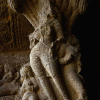Books
Aklekar, Rajendra B. 2014 Halt Station India: The Dramatic Tale of the Nation’s First Rail Lines. New Delhi: Rupa Publications India Pvt Ltd.
Dossal, Mariam. 1991. Imperial Designs and Indian Realities: The Planning of Bombay City, 1845-1875. Bombay; New York: Oxford University Press.
———2010. Theatre of Conflict, City of Hope: Bombay/Mumbai 1660 to Present Times. New Delhi: Oxford University Press.
Dwivedi, Sharada and Rahul Mehtrotra. 2001. Bombay: The Cities Within. Bombay: Eminence Designs Pvt Ltd.
Edwardes, S.M., James M. Campbell and Bombay Presidency. 1909-10. The Gazetteer of Bombay City and Island. Bombay: Times Press.
Hurd, John and Ian J. Kerr. 2012. India’s Railway History: A Research Handbook. Leiden; Boston: Brill.
Kerr, Ian J. 1995. Building the Railways of the Raj, 1850-1900. Delhi; New York: Oxford University Press.
———2006. Engines of Change: The Railroads That Made India (Moving Through History: Transportation and Society). Westport: Praeger.
London, Christopher W. Bombay Gothic. 2002. Mumbai: Jaico Publishing House.
Masselos, Jim. 2007. The City in Action: Bombay Struggles for Power. New Delhi: Oxford University Press.
Mehrotra, Rahul and Sharada Dwivedi. 2006. A City Icon: Victoria Terminus 1887 Now Chhatrapati Shivaji Terminus 1996. Bombay: Eminence Designs Pvt Ltd.
Morris, Jan and Simon Winchester. 2005. Stones of Empire: The Buildings of the Raj. New York: Oxford University Press.
Tindall, Gillian. 1992. City of Gold: The Biography of Bombay. Bombay: Penguin Books India.
Websites & Reports
Stephen Goodwin Howard’s MA dissertation (2012) for the University of York on CST 'examine[s] the claims of authors and historians that [CST] was the most important building of the entire British Empire [...], asking why a railway station should enjoy such a central place in empire'. etheses.whiterose.ac.uk/3198/2/VT6.pdf
UNESCO’s World Heritage Convention webpage for the Chhatrapati Shivaji Terminus, which contains the criteria for selection of CST as a World Heritage Site, an image gallery, a short video, maps and other documents. http://whc.unesco.org/en/list/945
UNESCO’s World Heritage Nomination File for Chhatrapati Shivaji Terminus. http://whc.unesco.org/en/list/945/documents/
Conservation architect Vikas Dilawari writes about managing Chhatrapati Shivaji Terminus, nine years after it was nominated as a World Heritage Site. http://www.vikasdilawari.in/content/np/articles/Context%20Magazine%20Vol%2010_Issue2_2013.pdf
Conservation architect Abha Narain Lambah reacts to the Mumbai 2008 terror attacks on the Chhatrapati Shivaji Terminus and the Taj Mahal Hotel. http://www.livemint.com/Politics/faG0NjHYbTIKwKJGbWsbaL/Mumbaikars-react-Abha-Narain-Lambah.html
'When CST became a target of the 2008 terrorist attacks, what was violated was much more than a railway station.' An article from The Guardian newspaper. http://www.theguardian.com/cities/2015/apr/21/chhatrapati-shivaji-terminus-cst-mumbai-railway-station
A photo and text story by National Geographic Traveller with podcasts from Mustansir Dalvi, Professor, Sir J.J. School of Architecture, on the hallmarks of Gothic architecture and the connection between two Gothic Revival buildings in Mumbai, CST building and the J.J. School of Art. http://www.natgeotraveller.in/web-exclusive/web-exclusive-month/cst-heritage/











